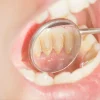Get information about Tooth Extraction treatment with the explanation of expert dentist Merve Özkan Akagündüz.
Tooth Extraction

Tooth Extraction, Doredent İstanbul
Although the most important function of teeth is to enable chewing, they also provide support for the tissues around the mouth. For this reason, the dentist's priority is to save and repair the natural tooth by treating it. After this comes the improvement of aesthetics. However, sometimes the damage or infection to the tooth may be severe enough to require removal of the tooth from the mouth. In this case, tooth extraction may be inevitable.
Tooth extraction is the process of removing the tooth from the jawbone. Before tooth extraction, the dentist numbs the relevant area with the help of local anesthesia. The numbing process occurs in a short time and the procedure can be started immediately afterwards. The extraction process begins by loosening the tooth from its position with a tool called an elevator. The aim here is to move the tooth in all directions, to ensure that it moves well and to prevent the root from breaking. After sufficient elevation is achieved, the tooth is grasped tightly with a hammer and removed. However, in some cases, no matter how much care is taken, the tooth may break and be pulled into pieces. In fact, in some cases (such as a bent root), the dentist may specifically cut the tooth into pieces and remove all the pieces separately. Although what I have explained may seem scary, this process is actually a painless process that can be completed in today’s conditions and usually within 10-15 minutes.
After tooth extraction, the patient is asked to bite on a sterile tampon and is asked to bite on this tampon for approximately 30-45 minutes. The aim here is to facilitate blood clotting at the extraction site. After the tampon is removed, there may be bleeding in the form of leakage, and this is normal. If there is excessive bleeding, it would be beneficial to consult your dentist. The patient is warned not to spit in order to prevent the blood clot from breaking. It is beneficial not to eat until the drowsiness passes. In addition, the patient is not recommended to smoke, drink alcohol, or consume very hot food or drinks for at least the first 24 hours after the extraction.
Painkillers and antibiotics prescribed by the doctor can be used to control pain and infection after the extraction. During this process, more attention should be paid to oral hygiene. Teeth can be brushed, taking care not to irritate the treated area. The shooting location should not be tampered with by language or anything else. Ice can be applied to prevent swelling.
What are the Causes of Tooth Extraction?
In cases where it is not possible to save the tooth with filling and root canal treatment, the last resort is extraction. The most important and common cause is deep tooth decay. Deep caries infect not only the hard tissues of the tooth but also the pulpal tissue, which contains a bundle of blood vessels and nerves. When the tooth becomes irreparable due to extensive decay, extraction is mandatory.
Gum diseases cause damage to the tissues around the teeth. This condition usually manifests itself as deepening of the pockets between the teeth and gums and receding gums. The progression of the disease can be prevented by taking necessary care of the patient and appropriate and effective treatments. In cases where gum disease progresses, the destruction of the tooth-supporting tissues may reach a level that requires tooth extraction.
If a vertical fracture occurs in the tooth, extending below the gum line, due to trauma or another reason, extraction of the tooth may be required.
Extraction of the tooth or teeth may be considered for orthodontic reasons. If there is sufficient crowding that prevents the teeth from aligning properly within the jawbone, tooth extraction may be considered for reasons such as ensuring midline symmetry. This decision should be made by the orthodontist who will perform the orthodontic treatment.
If the patient is planned to undergo treatments in which the person’s immune system is important, such as chemotherapy or radiotherapy, it is appropriate to extract teeth at risk of infection before these treatments.
Milk teeth can sometimes be found in the mouth without falling out, even though permanent teeth have emerged. In this case, extraction of the milk tooth is necessary.
Extraction of an impacted tooth may be considered due to its poor position, damage to other teeth, or cause cystic formations.
How Long Does Tooth Extraction Take?
Tooth extraction is a simple surgical procedure performed under local anesthesia. Considering today’s conditions, it is mostly carried out practically. The duration of tooth extraction is determined by factors such as its location in the mouth, whether it is single or multi-rooted, whether it is impacted or not, and whether it has root canal treatment or not.
Extraction of single-rooted front teeth is generally much easier and takes a shorter time than other multi-rooted teeth. However, extraction of teeth that are impacted, poorly positioned, and have roots close to anatomical formations takes longer and involves technical details. The experience of the dentist or oral surgeon in this regard is also one of the factors that affects the duration.
Merve Özkan Akagündüz
I was born in Edirne in 1988. In 2007, I began my master’s degree in Dentistry at Istanbul University (Çapa) Faculty of Dentistry and graduated in 2012.
In 2014, I started my specialization in the Department of Orthodontics at Süleyman Demirel University Faculty of Dentistry. In 2019, I earned the title of Orthodontist and was appointed to Çorlu ADSM, where I worked as an Orthodontic Specialist Dentist from 2019 to 2022.
As of 2024, I have been continuing my practice in my own clinic.








